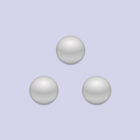Product Recommendations & Selection Criteria
Product Lines
Seeking nanoparticles for topical use or wound care technologies? Our BioPure Silver Nanospheres are sterile-filtered and guaranteed to have low endotoxin. Check out our product offerings and read more about the BioPure product line.
Size, Shape, & Surface Considerations
The antimicrobial efficacy of the silver source depends on the rate and duration of silver ion release, which can be modulated by selecting the size, shape, and surface coating of the added silver. In many cases, small silver nanoparticles are suggested to exhibit better antibacterial efficacy than their larger counterparts.
NanoComposix offer a variety of highly purified silver nanomaterials with different sizes, shapes, and surface coatings, that can be used for antimicrobial research studies or incorporated into devices and products.
Silver Nanoparticles as Antimicrobial Agents
The antimicrobial effects of silver have been known for over a century with the first known use traced back to the Greeks and Romans, who increased the potability of water by storing it in silver vessels. Recent research has demonstrated that silver ions are an effective antimicrobial yet have low toxicity to humans, making silver an attractive component in wound dressings, packaging materials, and anti-fouling surface coatings. Below is a brief overview of the proven utility of silver nanoparticles as antimicrobial agents.
Antiviral & immunomodulatory activity
Silver nanoparticles have garnered attention particularly for their antiviral properties.1 Scientists have reported that silver demonstrates inhibitory activities against a number of viruses including HIV-1, hepatitis B virus, and H1N1 influenza A virus.2-4 Another study looked at transmissible gastroenteritis virus (TGEV), a type of coronavirus that infects pigs, and found that silver nanoparticles were effective virucidal agents or inhibited viral entry into cells.5 nanoComposix silver nanoparticles have also been used to mediate a reduction in respiratory syncytial virus (RSV) replication in both epithelial cell lines and in infected BALB/c mice.6 With these considerations in mind, silver nanoparticles are finding myriad applications in the medical field to mitigate infection in patients and healthcare workers.7
Antibacterial Effects & Wound Care
Silver nanomaterials find common application in wound dressings8 due to their proven effectiveness against various strains of Staphylococci and Streptococcus, among other bacteria known to cause serious infection.9-12 Silver nanoparticles are also suggested to possess anti-inflammatory and would healing capabilities,13 and are used as an active ingredient in an array of commercially available topical products.
Food Storage & Food Safety
Silver nanoparticles are widely used and have been proven efficacious as an antimicrobial agent in food packaging technologies.14 Silver particles are understood to combat bacteria, fungi, yeasts, and viruses and can be easily integrated with functional polymers to increase the shelf life of packaged foods.15
References
Highlighted Links Feature nanoComposix Silver Nanoparticles
- Galdiero, S.; Falanga, A.; Vitiello, M.; Cantisani, M.; Marra, V.; Galdiero, M. “Silver Nanoparticles as Potential Antiviral Agents” Molecules 2011, 16 (10), 8894-8918.
- Lara, H. H.; Ayala-Nuñez, N. V.; Ixtepan-Turren, L.; Rodriguez-Padilla, C. "Mode of Antiviral Action of Silver Nanoparticles Against HIV-1" J. Nanobiotechnol. 2010, 8 (1), 1-10.
- Lu, L.; Sun, R. W.-Y.; Chen, R.; Hui, C.-K.; Ho, C.-M.; Luk, J. M.; Lau, G. K.; Che, C.-M. "Silver Nanoparticles Inhibit Hepatitis B Virus Replication" Antivir. Ther. 2008, 13, 253-262.
- Xiang, D.; Chen, Q.; Pang, L.; Zhang, C.-I. "Inhibitory Effects of Silver Nanoparticles on H1N1 Influenza A Virus In Vitro" J. Virol. Methods 2011, 178 (1-2), 137-142.
- Lv, X.; Wang, P.; Bai, R.; Cong, Y.; Suo, S.; Ren, X.; Chen, C. "Inhibitory Effect of Silver Nanomaterials on Transmissible Virus-Induced Host Cell Infections" Biomater. 2014, 35 (13), 4195-4203.
- Morris, D.; Ansar, M.; Speshock, J.; Ivanciuc, T.; Qu, Y.; Casola, A.; Garofalo, R. P."Antiviral and Immunomodulatory Activity of Silver Nanoparticles in Experimental RSV Infection" 2019, 11 (8), 732.
- Nakamura, S.; Sato, M.; Sato, Y.; Ando, N.; Takayama, T.; Fujita, M.; Ishihara, M. "Synthesis and Application of Silver Nanoparticles (Ag NPs) for the Prevention of Infection in Healthcare Workers" Int. J. Mol. Sci. 2019, 20, 3620.
- Hilfenhaus, P.; John, H.; Buettner, H.Antimicrobial Wounddressing. United States Patent US 7,270,721. United States Patent and Trademark Office. 18 Sept. 2007.
- Surwade, P.; Ghildyal, C.; Weikel, C.; Luxton, T.; Peloquin, D.; Fan, X.; Shah, V. "Augmented antibacterial activity of ampicillin with silver nanoparticles against methicillin-resistant Staphylococcus aureus (MRSA)" Jpn. J. Antibiot. 2018, 72, 50-53.
- Niska K.; Knap, N.; Kędzia, A.; Jaskiewicz, M.; Kamysz, W.; Inkielewicz-Stepniak, I. "Capping Agent-Dependent Toxicity and Antimicrobial Activity of Silver Nanoparticles: An In Vitro Study. Concerns about Potential Application in Dental Practice" Int. J. Med. Sci. 2016, 13, 772-782.
- Kang, J; Dietz, M. J.; Hughes, K.; Xing, M.; Li, B. "Silver nanoparticles present high intracellular and extracellular killing against Staphylococcus aureus" J. Antimicrob. Chemother. 2019, 74, 1578-1585.
- Parvekar, P.; Palaskar, J.; Metgud, S.; Maria, R.; Dutta, S. "The minimum inhibitory concentration (MIC) and minimum bactericidal concentration (MBC) of silver nanoparticles against Staphylococcus aureus" Biomater. Investig. Dent. 2020, 7 (1), 105-109.
- Gunasekaran, T.; Nigusse, T.; Dhanaraju, M. D. "Silver Nanoparticles as Real Topical Bullets for Wound Healing" J. Am. Coll. Clin. Wound Spec.. 2012, 3, 82-96.
- Istiqola, A.; Syafiuddin, A. "A review of silver nanoparticles in food packaging technologies: Regulation, methods, properties, migration, and future challenges" J. Chin. Chem. Soc. 2020, 1-15.
- Carbone, M.; Donia, D. T.; Sabbatella, G.; Antiochia, R. "Silver nanoparticles in polymeric matrices for fresh food packaging" J. King Saud Univ. Sci. 2016, 28, 273-279.
- Mahdieh, Z.; Mitra, S.; Holian, A. "Core–Shell Electrospun Fibers with an Improved Open Pore Structure for Size-Controlled Delivery of Nanoparticles" ACS Appl. Polym. Mater. 2020, 2 (9), 4004-4015.
- Belluco, S.; Losasso, C.; Patuzzi, I.; Rigo, L.; Conficoni, D.; Gallocchio, F.; Cibin, V.; Catellani, P.; Segato, S.; Ricci, A. "Silver as Antibacterial toward Listeria monocytogenes" Front. Microbiol. 2016, 7, 307.
- Casey, B. J.; Dair, B. J. "Influence of Size on Antimicrobial Activity of Silver Nanoparticles" Adv. Sci. Eng. Med. 2015, 7 (2), 112-119.


